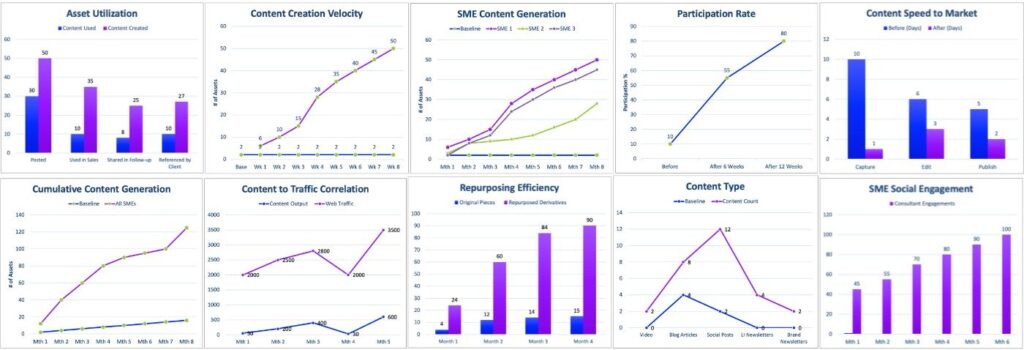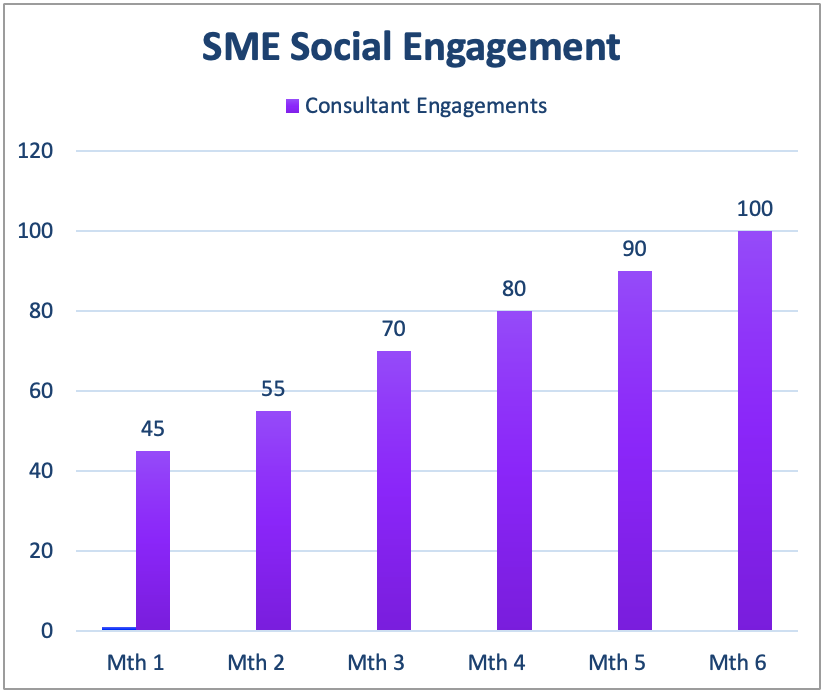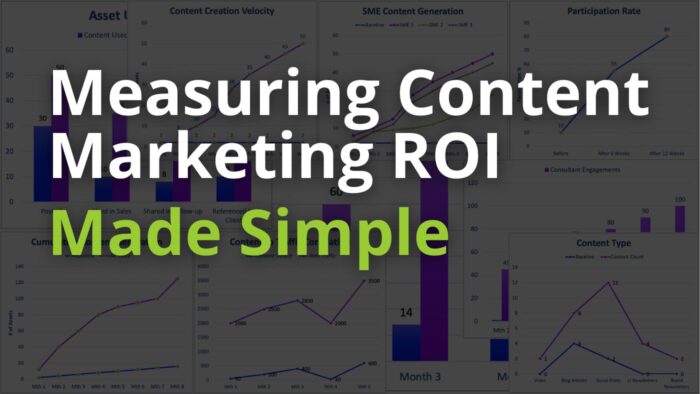Content marketing ROI is often miscalculated because it is based on a short time frame, a single piece of content, or even a single campaign. Instead, it should be measured on whether or not your overall content engine is working.
These 10 KPIs will help you track performance, engagement, and real business value for your content marketing efforts. First, let’s answer the question that remains on every marketer’s mind.
Why isn’t content marketing ROI easier to prove?
Content marketing drives awareness, builds trust, and supports sales.
But we tend to measure it like paid ads – expecting instant conversions or isolated wins.
That doesn’t work, and it sets marketers up for failure.
Content ROI is a system metric. It is not an asset measurement, and surely not a sales measurement. It’s about how well your team creates, distributes, and uses content over time.
These 10 KPIs help you demonstrate that your content engine is functioning effectively and delivering business value.

1. Are your subject matter experts contributing to content, and how often?
In measuring Subject Matter Experts’ contribution to content generation, of course, some SMEs will be prolific than others. They may have more to say, more experience, or simply be more willing to create content.
By measuring SME output individually, you’ll understand whether you need to drive more participation or whether valuable knowledge is being withheld. Your organization may have agents, consultants, analysts, or technicians, each with unique insights and perspectives. You want to ensure that those areas of knowledge are represented in your brand’s content.
That’s why this KPI matters. It ensures that the unique voices from your company are being heard and that your company’s expertise is being made visible to prospects.

2. Are we growing content participation across the organization?
Measuring SME participation rate allows you to examine whether your internal efforts to engage experts are working.
Over time, you should see more SMEs contribute and share their knowledge.
You get there by running internal campaigns and showing participants what’s in it for them. Show how it contributes to their visibility, credibility, and influence. This KPI also lets you measure whether that message is landing.
If the numbers go up, you’re building momentum. If not, your engagement efforts may need a new angle.

3. Are we producing content at a steady, scalable pace?
Your goal here is to track how your team is able to increase the amount of content you make and maintain a consistency that matches your team’s bandwidth.
The goal isn’t to crank out AI-generated slop or chase volume. The goal is to create good content and hold yourself accountable to consistent output.
Once you reach a consistent level, then, and only then, do you increase velocity.
That’s where efficiency comes in. This KPI connects consistency to scale, without compromising quality.

4. Is our content library growing in a way that supports sales?
When measuring cumulative content generation, the goal is to see compound growth in your content library.
Over time, you should have a broader collection of assets, both timely and evergreen, that support sales conversations.
A flat line here could signal fading internal communication around content’s value. It may also show that SME enthusiasm is dropping or that there’s a gap in your production process.
Consistency feeds cumulative growth.
If you’re creating consistently, your library will reflect that growth. If not, this KPI will make that clear.

5. Is Sales actually using the content created by Marketing?
When measuring assets used by sales, you need a multi-channel approach.
You can measure this by:
- Links shared by reps
- Asking sales what content they’ve used this week
- Checking Digital Asset Management (DAM) platforms
- Reviewing CRM/email activity for attachments and tracked content
- Looking at prospect journeys for engagement with content
Depending on your tech stack, some of this may be automated.
But often, the best method is to simply ask sales what helped them close or move a deal.
This KPI tells you whether content is just sitting in a library or being put to work in conversations that matter.

6. Are we creating a diverse mix of content formats?
Content format priority can vary by organization, and their value can change over time.
For some, video brings the most traction. For others, it could be social posts or research.
Start with a balanced mix.
Then adjust based on what your audience responds to and what channels perform best.
But before you make any decisions, you need the data.
Track which formats you’re producing and how much of each. Without that, you’re guessing instead of leading.

7. Is our content driving traffic back to our website?
All of your content won’t point back to your website – and it shouldn’t.
But if your content program is doing its job, it should build curiosity and attention for your brand, which does lead to more site traffic.
So, track the correlation, not causation, between content output (across all platforms) and website traffic.
If you’re producing more content and better content, you should see traffic rise over time.
If traffic flatlines while content increases, something’s off.
If traffic rises but output hasn’t, maybe past efforts are compounding. This KPI helps you see those patterns clearly.

8. Are our consultants showing up consistently on social?
Vanity metrics, such as likes and impressions, are fading as performance indicators.
We don’t control the algorithms, but we do control how often and how meaningfully we show up.
That’s what this KPI is about:
Tracking the lift from where you started, not comparing your people to competitors, and not comparing one SME to another.
Set a baseline and watch for improvement.
You don’t need millions of views. You need the right people to see your content when they’re paying attention.
This metric helps you track your presence and consistency rather than your popularity.

9. Are we repurposing content effectively to reach more channels?
No piece of content should live in just one format.
A minimum ratio of 1:3 is a good benchmark. One asset should create three others.
Being efficient at repurposing has a direct connection to ROI.
It’s a waste to create a great piece of content and let it sit. Your prospects have their individual preferred ways to consume content and that could be video, audio, blogs, social, or email.
You need your content in the formats your audience actually uses.
And you get there through intentional, repeatable repurposing.

10. How quickly can we publish new content?
Time is money, and your competition may be educating your prospects faster and more often than you are.
The longer it takes to create content, the more that your content costs.
That’s a direct hit to your ROI.
I’m not talking about rushing content out the door.
Your goal is to analyze your process and find ways to create high-value content faster, from capture to editing to publishing.
This KPI helps you keep your time-to-market low, your investment efficient, and your return strong.

Takeaway
These 10 KPIs work together to show what really matters:
- Contribution reveals knowledge flow
- Participation shows buy-in
- Velocity proves consistency
- Growth reflects momentum
- Sales usage confirms alignment
- Format mix shows adaptability
- Traffic correlation indicates visibility
- Engagement captures presence
- Repurposing boosts scalability
- Speed controls cost
Measure what matters and don’t stop at simply what is visible.
These metrics help you connect your content engine to business results that leadership can understand and support.
Ready to apply this?
Start with a Content Engine Assessment:
- Map your current workflows
- Benchmark these 10 KPIs
- Identify areas where production, usage, or engagement can improve
- Align your team and your tools around consistent output
- Build toward a content engine that scales with your business
Need help?
If you’re ready to evaluate your content system or build one that supports real business outcomes, Content Monsta can help.
We’ll audit your approach, find the gaps, and help you build a content engine that delivers measurable results.
→ Contact Content Monsta to get started.
About the Author
A. Lee Judge is the cofounder of Content Monsta, a podcast and video production agency that helps businesses create content to drive sales and marketing results. He is also the author of CASH: The 4 Keys to Better Sales, Smarter Marketing, and a Supercharged Revenue Machine.


